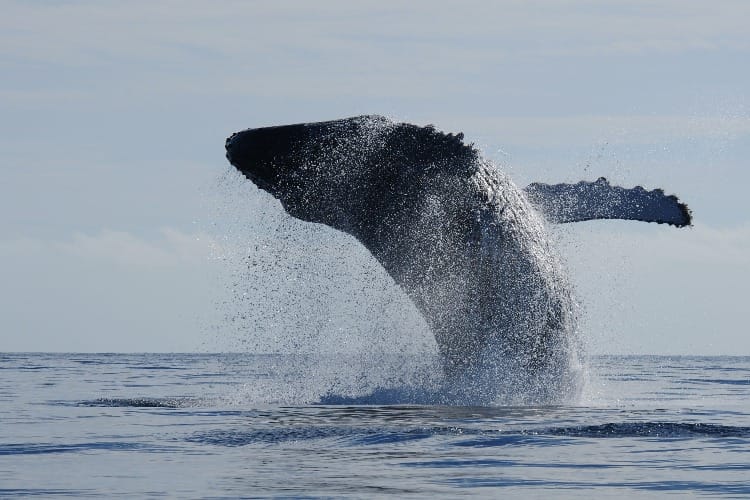Wildlife management aided by statistics

Statisticians at St Andrews have developed distance sampling survey methods and software which have allowed governmental bodies and NGOs to make better decisions about the management and conservation of diverse wildlife populations.
Distance sampling is a group of related methods in which a systematic grid of lines or points is randomly superimposed on a study area. An observer then travels along each line or to each point and measures the distance of any detected animals from the line or point (typically using laser rangefinders on land or using binoculars with reticles for marine surveys). Statisticians can then use these data to estimate the abundance and spatial density of animal and plant populations.
Distance sampling techniques have proven effective for sampling a vast range of diverse wildlife populations, from whales and trees to ants and flowers. Distance sampling is also highly adaptable and can be used to survey a wide variety of populations, and it can be combined with other techniques such as acoustic surveys, camera-trap studies, mark-recapture, etc.
Professor Stephen Buckland and his ‘Distance team’ have been working on distance sampling methods and best practice since the early 1990s and are recognised as world leaders in this area.
The distance team has produced several books which set the standards for conventional distance sampling. The latest of these, Distance Sampling: Methods and Applications, appeared in 2015. The team also developed software that has become the industry standard and has over 30,000 registered users from around 115 countries.
The group’s ongoing research has led to many advances in distance sampling:
- Multiple-covariate distance sampling
Takes into account and quantifies the effects of variables such as the weather, the observer, or animal behaviour on the probability of detection. - Full model-based methods
Used to analyse designed experiments to assess whether a treatment, an impact, or a new habitat management strategy affects animal density. - Spatial distance sampling
Relates animal density to geographical variables such as topography, environment, and habitat. This accounts for the fact that animals do not generally have uniform distributions. - Automated survey design methods
Removes the need to construct survey designs by hand within what may be very complex regions. - Mark-capture distance sampling methods
Allows estimation when not all animals on the line can be detected, such as occurs in whale surveys.
The distance sampling methods developed at the University of St Andrews are widely used for:
- informing decisions on levels of catch or cull of natural resources (for example, fisheries or deer)
- monitoring the status of vulnerable, threatened or endangered populations (for example, elephants, apes, whales or polar bears)
- routine or statutory monitoring (for example, the UK Breeding Bird Survey).

Impact
- Endangered species. The distance sampling methods have been used to help assess the risk of extinction and to monitor the results of management action for endangered species, such as Baltic harbour porpoises, elephants and great apes.
- Globally-used software. User-friendly software, Distance, is the global industry standard for wildlife population estimation based on sightings surveys and is used by the US Navy, US National Park Service, Fisheries and Oceans Canada, and the Wildlife Conservation Society, among others.
- Oil production. Acoustic distance sampling methods have been used as methods for monitoring the impacts of seismic exploration and oil production on animal populations.
Researchers involved
- Professor Stephen Buckland, School of Mathematics and Statistics
- Professor David Borchers, School of Mathematics and Statistics
- Professor Len Thomas, School of Mathematics and Statistics
- Dr Eric Rexstad, School of Mathematics and Statistics
Credits
Publications
- Borchers, DL, Laake, JL, Southwell, C, and Paxton, CGM (2006). “Accommodating unmodeled heterogeneity in double-observer distance sampling surveys”. Biometrics 62, 372-378. DOI: 10.1111/j.1541-0420.2005.00493.x
- Buckland, ST, Anderson, DR, Burnham, KP, Laake, JL, Borchers, DL, and Thomas, L (eds) (2004). Advanced Distance Sampling. Oxford University Press, Oxford.
- Buckland, ST, Laake, JL and Borchers, DL (2010). “Double-observer line transect methods: levels of independence”. Biometrics 66, 169-177. DOI: 10.1111/j.1541-0420.2009.01239.x
- Buckland, ST, Rexstad, EA, Marques, TA, and Oedekoven, CS (2015). Distance Sampling: Methods and Applications. Springer, New York.
- Buckland, ST, Rexstad, E, Thomas, L, and Borchers, DL (2016). “Distance sampling surveys of population size: enabling better decision-making by wildlife managers.” Pg. 45-51 in UK Success Stories in Industrial Mathematics, P. Aston, T. Mulholland and K. Tant (eds). Springer, New York.
- Hedley, SL, and Buckland, ST (2004). “Spatial models for line transect sampling”. Journal of Agricultural, Biological and Environmental Statistics 9, 181-199. DOI: 10.1198/1085711043578
- Langrock, R, Borchers, DL and Skaug, H (2013). “Markov-modulated nonhomogeneous Poisson processes for modeling detections in surveys of marine mammal abundance”. Journal of the American Statistical Association. DOI: 10.1080/01621459.2013.797356
- Thomas, L, Buckland, ST, Rexstad, EA, Laake, JL, Strindberg, S, Hedley, SL, Bishop, JRB, Marques, TA, and Burnham, KP (2010). Distance software: design and analysis of distance sampling surveys for estimating population size. J. App. Ecol. 47, 5-14. DOI: 10.1111/j.1365-2664.2009.01737.x